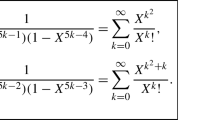Abstract
Riordan matrices are infinite lower triangular matrices corresponing to certain operators in the space of formal power series. In the paper, we introduce analogous matrices for the space of Dirichlet formal series. It is shown that these matrices form a group, which is analogous to the Riordan group. An analog of the Lagrange inversion formula is given. As an example of the application of these matrices, a method for obtaining identities analogous to those obtained by using Riordan matrices is considered.
Similar content being viewed by others
References
L.W. Shapiro, S. Getu, W. J. Woan and L. C. Woodson, “The Riordan group,” Discrete Appl.Math. 34 (1-3), 229–339 (1991).
R. Sprugnoli, “Riordan arrays and combinatorial sums,” Discrete Math. 132, 267–290 (1994).
R. Sprugnoli, “Riordan arrays and Abel–Gould identity,” Discrete Math. 142, 213–233 (1995).
D. Merlini, D. G. Rogers, R. Sprugnoli and M. C. Verri, “On some alternative characterizations of Riordan arrays,” Canad. J. Math. 49 (2), 301–320 (1997).
W. Wang and T. Wang, “Generalized Riordan arrays,” Discrete Math. 308, 6466–6500 (2008).
P. Barry, A Study of Integer Sequences, Riordan Arrays, Pascal-like Arrays and Hankel Transforms (University College Cork, 2009).
D. E. Knuth, “Convolution polynomials,” Mathematica J. 2 (4), 67–78 (1992).
A. Sowa, “Factorizing matrices by Dirichlet multiplication,” Linear Algebra Appl. 438 (5), 2385–2393 (2013).
A. Sowa, “The Dirichlet Ring and Unconditional Bases in L 2[0, 2π],” Funktsional. Anal. i Prilozhen. 47 (3), 75–81 (2013) [Funct. Anal. Appl. 47 (3), 227–232 (2013)].
A. Sowa, “On the Dirichlet matrix operators in sequence spaces,” Appl. Math. (Warsaw) 44 (2), 185–196 (2017).
S. K. Lando, Lectures on Generating Functions (MTsNMO, Moscow, 2007) [in Russian].
S. K. Lando, Introduction to Discrete Mathematics (MTsNMO, Moscow, 2012) [in Russian].
J. Riordan, Combinatorial Identities (Robert E. Krieger Publishing Co., Huntington, NY, 1979; Nauka, Moscow, 1982).
Author information
Authors and Affiliations
Corresponding author
Additional information
Russian Text © The Author(s), 2019, published in Matematicheskie Zametki, 2019, Vol. 106, No. 4, pp. 506–518.
Rights and permissions
About this article
Cite this article
Burlachenko, E.V. The Riordan–Dirichlet Group. Math Notes 106, 514–525 (2019). https://doi.org/10.1134/S0001434619090219
Received:
Revised:
Accepted:
Published:
Issue Date:
DOI: https://doi.org/10.1134/S0001434619090219



